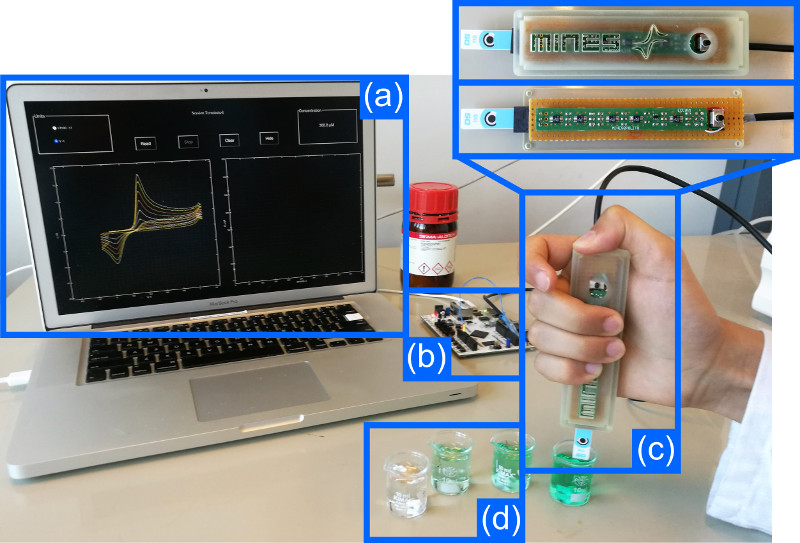Politecnico di Torino & EPFL joint research project
Contacts:
Simone Aiassa, PhD student, Politecnico di Torino-DET, EPFL-IC-LSI ([email protected])
Sandro Carrara, Dr MER, EPFL-IC-LSI ([email protected])
Danilo Demarchi, Professor, Politecnico di Torino-DET ([email protected])
Motivation
Every year, 30,000 people undergo anaesthesia and remain awake, feeling pain, many more are put into deep or prolonged chemical coma. Proper anaesthesia requires the achievement of a specific concentration of drugs. Today, prediction errors in control models reach 25% due to patients diversity. The continuous monitoring of anaesthetic would contribute to better individualization of patients management.
Conventional system to monitor the Depth of Anaesthesia (DOA), such as Bi-Spectral Index (BIS), show some limitations due to high inter-patient variability and the usage of predictive models. The Therapeutic Drug Monitoring (TDM) can measure the actual drug concentration in the patient, allowing a dynamic adjustment of the anaesthetic infusion to meet personal requirements. Nowadays, no commercially-available system can exploit a real-time point-of-care anaesthetic monitoring, due to the lack of technologies capable of reading anaesthetics and possible to be integrated into a simple object. Electrochemical investigation can be adopted to measure the therapeutic compounds (Propofol, Midazolam, and Paracetamol), in particular, Cyclic Voltammetry (CV) and Differential Pulse Voltammetry (DPV) are highly attractive due to fast measurements, multi-sensing, and high sensitivity.
Goal
The aim of the project is the development of a fully portable bio-sensor for automatic continuous monitoring of infused drug in the patient’s blood for improved anesthesiology practice. We envision a portable intelligent syringe to monitor the delivery of anaesthetic compounds during surgery. The system requires to be portable, low cost, small, and low power, the sampling must be autonomous, intelligent, and on-line.

Concept of the proposed system: the portable syringe provides to the anaesthesiologist in real-time the concentration of the drugs infused in the patient under anaesthesia.
Highlights
We present a portable-pen able to measure at the point-of-care the delivery-rate of therapeutic compounds during surgery, to overcome the lack of commercially-available systems to monitor on real-time the anaesthetics. Considered the requirements, the design of the system is based on a bio-inspired event-based approach to guarantee low complexity and low power consumption. Custom Printed Circuit Board (PCB) implemented with Commercial Off-The-Shelf (COTS) components, while a commercial Screen-Printed Electrode (SPE) acts as an electrochemical sensor for testing. Our bio-sensor electronic-interface relies on quasi-digital to analog conversion, and vice-versa. The system has been validated through an exhaustive comparison, between the proposed system and a lab instrument, considering as benchmark drug the paracetamol (APAP). The results show a 95% power consumption reduction and a 92% area decrease w.r.t. previously presented implementation, highlighting that the proposed approach is the best suitable for the required portable smart system.

The prototype: the portable pen provides on real-time on the screen the concentration of drug present in the sample.
Acknowledgement
This work is supported by Politecnico di Torino and Compagnia di San Paolo under the initiative Joint research projects with top universities.

References
- S. Aiassa, R. Terracciano, S. Carrara, and D. Demarchi, “Biosensors for Bimolecular Computing: a Review and Future Perspectives”, BioNanoScience, 2020.
- A. Tuoheti, S. Aiassa, F. Criscuolo, F. Stradolini, I. Tzouvadakiz, S. Carrara, and D. Demarchi, “New Approach for Making Standard the Development of Biosensing Devices by a Modular Multi-purpose Design”, IEEE Transactions on NanoBioscience, 2020
- S. Aiassa, J. D. González Martínez, D. Demarchi, and S. Carrara, “New Measurement Method in Drug Sensing by Direct Total-Charge Detection in Voltammetry”, 2020 IEEE International Symposium on Medical Measurements and Applications (MeMeA), 2020. Sensor Council Best Paper Award.
- S. Aiassa, F. Grassi, R. Terracciano, S. Carrara, and D. Demarchi, “Live Demonstration: Quasi-Digital Portable Pen to Monitor Anaesthetics Delivery“, 2019 IEEE Biomedical Circuits and Systems Conference (BioCAS), Nara, 2019.
- S. Aiassa, F. Stradolini, A. Tuoheti, S. Carrara, and D. Demarchi, “Quasi-Digital Biosensor-Interface for a Portable Pen to Monitor Anaesthetics Delivery”, 15th Conference on Ph.D. Research in Microelectronics and Electronics (PRIME), 2019.
- S. Aiassa, S. Carrara, and D. Demarchi, “Optimized Sampling Rate for Voltammetry-Based Electrochemical Sensing in Wearable and IoT Applications”, IEEE Sensors Letters, 2019.
- S. Aiassa, S. Carrara, and D. Demarchi, “Event-based Portable Pen for Monitoring Anaesthetics Delivery”, 51th Annual Meeting of the Associazione Società Italiana di Elettronica, 2019.
- S. Aiassa, S. Carrara, D. Demarchi, “Supplementary Material for Optimized Sampling Rate for Voltammetry-Based Electrochemical Sensing in Wearable and IoT Applications”, IEEE Dataport, 2019.